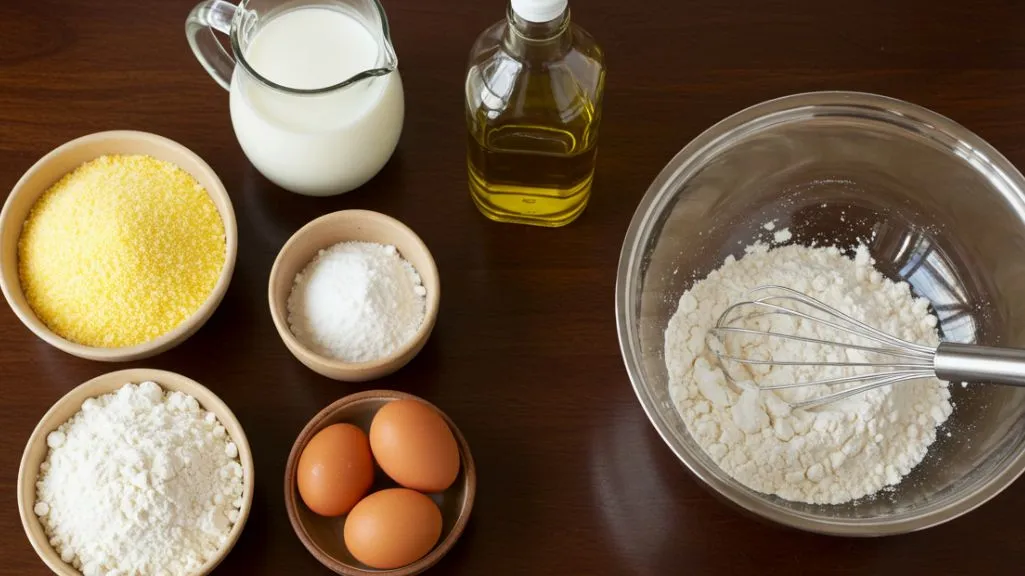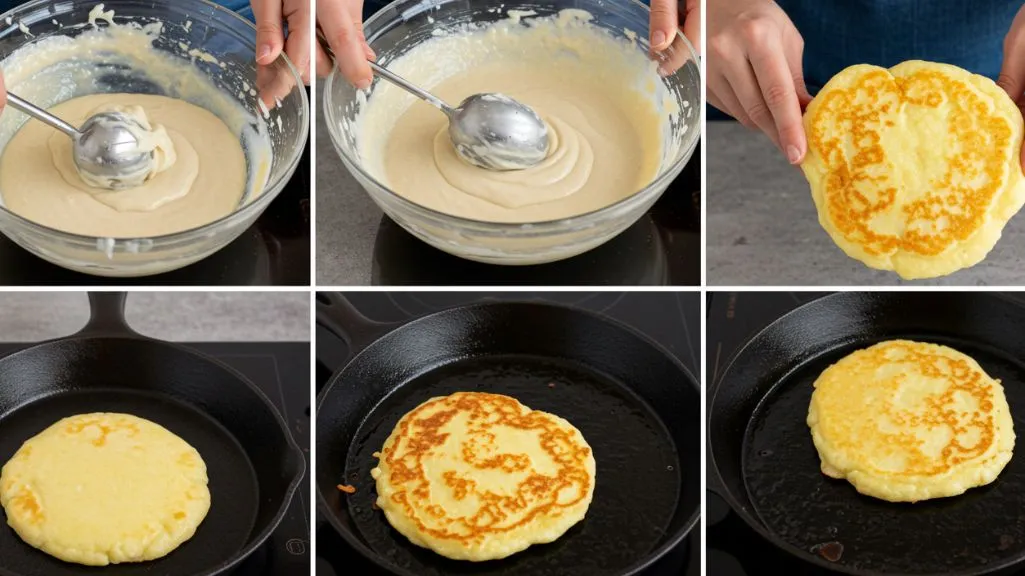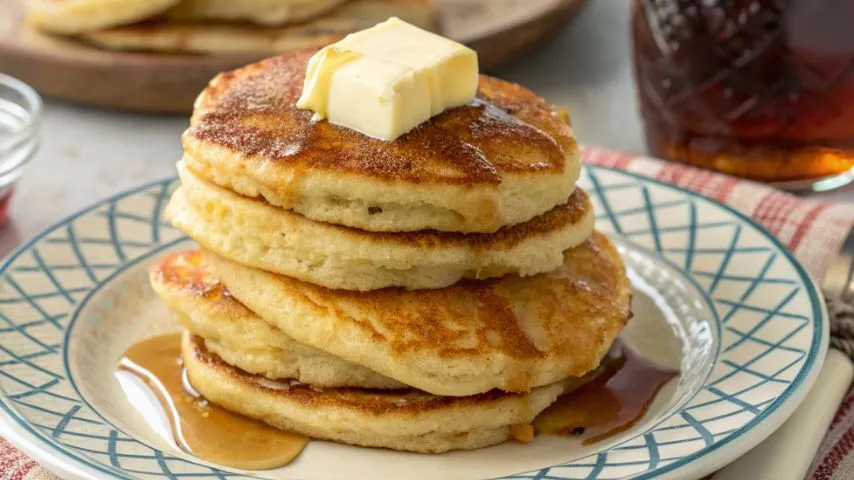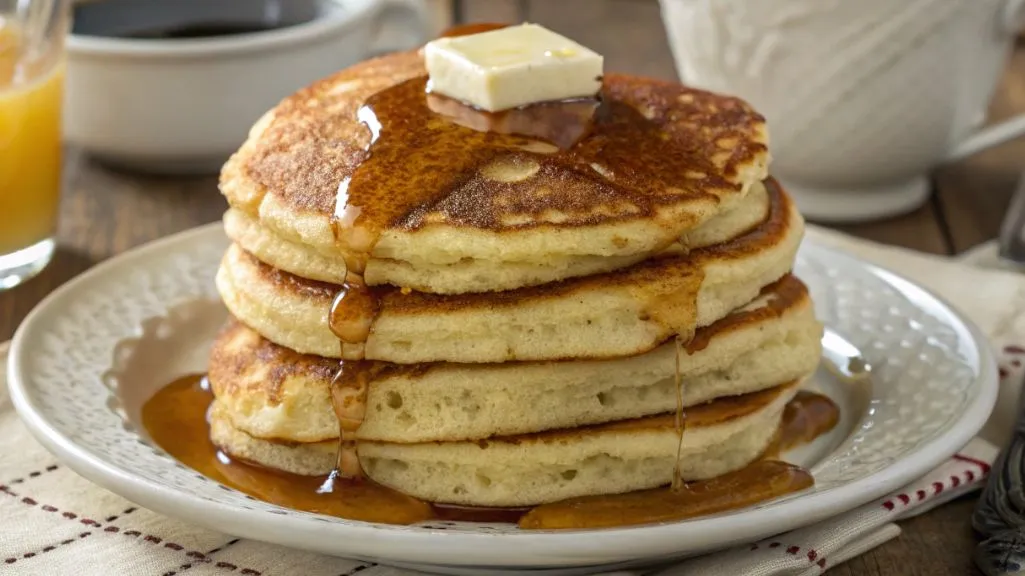There’s something about a golden, crispy hoe cake sizzling in a cast iron skillet that just whispers Southern comfort. Whether you know them as fried cornbread, Johnnycakes, or simply cornmeal pancakes, these Southern treats have stood the test of time — and for good reason. In this article, we’ll walk you through the best hoe cakes recipe, perfect for breakfast (or any meal, honestly).
We’ll start by diving into what hoe cakes really are, how they differ from other Southern staples, and why they’ve earned their spot on countless tables for generations. From ingredients and step-by-step cooking tips to storage hacks and creative variations, this guide is packed with everything you need to make mouthwatering hoe cakes at home. Plus, we’ll sprinkle in some Southern history and answer the most common questions folks ask online.
Let’s dig into this crispy, savory slice of the South!
Table of Contents
Introduction to Hoe Cakes
What Are Hoe Cakes?
Hoe cakes — also called cornmeal pancakes, fried cornbread, or even Johnnycakes — are a type of rustic flatbread made primarily from cornmeal. Fried to golden perfection, they’re crisp on the outside, soft on the inside, and just bursting with old-school charm. Often served for breakfast in the Deep South, these little cakes can swing sweet or savory, depending on how you dress ’em up.
Though simple in ingredients, their taste is anything but. Picture this: a warm hoe cake, slathered with butter, maybe a drizzle of honey or maple syrup… now that’s comfort food!
Why They’re a Southern Staple
Born out of necessity and tradition, hoe cakes have roots that run deep through Southern soil. Back in the day, they were cooked on flat metal hoes (yep, the garden kind) over open fires — which is where the name likely comes from. Today, they’re usually fried in skillets, but that old-school simplicity remains.
They’ve endured not just for nostalgia’s sake but because they’re easy to whip up, made from pantry staples, and undeniably delicious. Whether paired with collard greens, Southern peas, or just eaten hot off the griddle, hoe cakes belong in every Southern kitchen.
And guess what? This hoe cakes recipe we’re diving into next is the real deal. Simple, quick, and seriously tasty.
Ingredients and Kitchen Tools
Essential Ingredients for the Best Hoe Cakes Recipe

To get that classic Southern flavor just right, you’ll need a few staple ingredients. The beauty of a traditional hoe cakes recipe lies in its simplicity — nothing fancy, just good ol’ pantry items doing their magic.
Here’s what you’ll need:
- Self-rising cornmeal – This adds the signature crunch and deep corn flavor.
- Self-rising flour – It helps give the cakes structure and a touch of fluffiness.
- Eggs – They bind the batter and add a rich texture.
- Buttermilk – This brings that tangy depth you can’t get from plain milk.
- Sugar – Just a pinch to balance the savory notes.
- Vegetable oil or bacon grease – For frying and flavor, you can’t go wrong with a splash of southern tradition.
- Water – To help get the batter to the right consistency.
Want a dairy-free version? Swap in almond milk with a splash of lemon juice — it mimics buttermilk pretty well.
Traditional vs. Modern Substitutions
Not everyone keeps buttermilk or self-rising flour on hand. But don’t worry — this hoe cakes recipe is pretty forgiving. If you only have all-purpose flour, just add baking powder and a little salt. No buttermilk? Stir a tablespoon of vinegar into regular milk and let it sit for five minutes.
Jiffy mix or Bisquick? Sure, they’ll work in a pinch — just don’t expect that same deep-down Southern flavor. Trust us, from-scratch makes a world of difference.
Step-by-Step Cooking Instructions

Mixing the Batter for Hoe Cakes
Ready to cook? First things first — let’s mix that batter. Grab a large mixing bowl and whisk together your self-rising cornmeal, self-rising flour, and sugar. In another bowl, beat your eggs and pour in the buttermilk. Mix those wet ingredients well.
Slowly pour the wet blend into the dry ingredients and mix. Add about a half cup of water and a quarter cup of vegetable oil. Stir everything just until combined. Don’t overmix — a few lumps are fine. The batter should be thick, but if it feels like wet cement, go ahead and add another tablespoon of water at a time until it loosens up.
How to Fry Hoe Cakes in a Skillet Like a Pro
Time to heat things up. Place a cast iron skillet (or heavy non-stick pan) on medium heat and add about a quarter cup of oil. Once the oil’s shimmering — not smoking — you’re ready to go.
Scoop about two tablespoons of batter per hoe cake. I like using a small ice cream scoop for even sizes, but a spoon works just fine. Drop the batter into the skillet, and don’t crowd the pan. Give ‘em space to get golden.
Cook each hoe cake for about 1–2 minutes on one side, until bubbles form and the edges look crispy. After that, turn over and cook until the other side is golden brown.
Lay the finished cakes on a paper towel to drain off extra oil. And here’s the secret — serve ‘em warm. Nothing beats that fresh-from-the-skillet crunch.
Whether you top them with maple syrup, honey, or eat them plain with a side of collard greens, this hoe cakes recipe will have you hooked from the first bite.
Serving Suggestions and Variations

Breakfast Pairings: Syrup, Butter, Eggs & More
Let’s be honest — hoe cakes straight off the skillet are already little bites of joy. But with the right pairings? Oof, they level up real fast.
For a classic Southern breakfast, stack a few hoe cakes, slather ’em with butter, and pour on some maple syrup or honey. Add a couple of fried eggs, some crisp bacon, and a scoop of creamy grits, and you’ve got yourself a plate worthy of a front porch feast.
Don’t stop there. Try them with sausage gravy or topped with scrambled eggs and cheddar. These golden cakes soak up all the flavor — just like a sponge, but tastier.
Savory & Sweet Variations to Try
Here’s where it gets fun. This hoe cakes recipe is flexible, so don’t be afraid to play around.
Want a spicy kick? Stir chopped jalapeños into the batter. Craving something rich? Add bits of cooked bacon or a handful of sharp cheddar cheese. You can even go sweet — mix in a pinch of cinnamon and sugar, or top finished cakes with a fruit compote or pecan butter.
Feeling extra adventurous? Crumble a warm hoe cake into a glass of cold buttermilk — it’s an old-school Southern treat!
For more delicious recipes, check out our main recipe collection. There’s always something new to discover in the kitchen!
The History Behind Hoe Cakes
Where the Name “Hoe Cakes” Comes From
This humble dish has a backstory that’s just as rich as its flavor. The term “hoe cake” likely comes from the days when field workers in the American South would cook cornmeal patties on the flat, metal blades of their hoes over an open fire. Talk about resourceful cooking!
These early hoe cakes were a staple for enslaved people, Native Americans, and poor settlers — folks who made do with simple ingredients and rustic tools. Over time, the dish found its way onto the breakfast tables of homes all across the South.
Johnnycakes vs. Hoe Cakes – A Historical Comparison
Though often confused, Johnnycakes and hoe cakes aren’t exactly the same. Johnnycakes are typically a New England thing — made with white cornmeal and often cooked without any flour or buttermilk. They’re flatter, denser, and not quite as fluffy as a hoe cake.
The Southern hoe cakes recipe, by contrast, includes both cornmeal and flour, and uses buttermilk for a softer, richer texture. They’re fried, not baked, and usually served piping hot.
So while these two cousins share roots in early American cooking, it’s the Southern hoe cake that brings the crispy edge and tender bite we all crave.
Expert Tips and Troubleshooting
How to Fix Too Thick or Too Thin Batter
Let’s face it — batter can be a bit tricky. If your hoe cake batter is too thick, you’ll end up with dry, heavy cakes. If it’s too thin, they’ll spread too much and turn out flimsy.
Here’s the fix: Add water one tablespoon at a time if it feels like wet dough. The goal is a pourable batter, thick enough to hold shape, but not so stiff it clumps. On the flip side, if your batter gets watery, sprinkle in a little more cornmeal or flour to firm it up.
This hoe cakes recipe is pretty forgiving, so don’t stress — a few tweaks will get you there.
How to Keep Hoe Cakes Warm Before Serving
No one likes cold hoe cakes. If you’re cooking in batches, preheat your oven to 225°F and place finished cakes on a baking sheet inside. That way, they’ll stay warm without drying out.
Another trick? Stack them with parchment paper between each one and cover with foil to trap heat. Don’t use the microwave — it makes them soggy.
Want to impress guests? Serve your hoe cakes straight from the skillet. The sizzle and that crispy edge? Unmatched.
Storing, Reheating & Make-Ahead Tips
Refrigeration and Freezer Tips for Hoe Cakes
Got leftovers? Lucky you! This hoe cakes recipe stores like a champ. Just pop any extras into an airtight container and stash them in the fridge. They’ll stay fresh for up to 4 days.
Want to freeze them? Go ahead. Place parchment paper between each cake to keep them from sticking, then seal tightly in a freezer bag. They’ll hold up for 3 months without losing that crispy charm.
Reheating Methods and Make-Ahead Options
To reheat, skip the microwave. Instead, use an oven at 400°F for 4 minutes or toss them in the air fryer for a similar time. They’ll come out hot, crisp, and just like new.
Making breakfast ahead of time? You can mix the batter a day or two in advance and store it covered in the fridge. When ready, give it a quick stir and get frying. It’s a great way to save time on busy mornings.
FAQs (People Also Ask)
Q: What’s the difference between hoe cakes and pancakes?
While both are cooked on a griddle or skillet, hoe cakes are made primarily with cornmeal, giving them a crispier texture and richer, earthier flavor. Pancakes, on the other hand, are typically made with all-purpose flour, resulting in a softer and fluffier bite. Pancakes are often sweet, while hoe cakes can be sweet or savory depending on how they’re served.
Q: What is a hoecake made of?
A traditional hoecake is made with cornmeal, self-rising flour, eggs, buttermilk, and a bit of oil or fat. This simple batter is pan-fried in a hot skillet — often cast iron — until crispy on the edges and golden brown. Some variations include sugar, onions, cheese, or even bacon.
Q: What’s the difference between cornbread and hoecake?
The key difference lies in texture and cooking method. Cornbread is usually baked in an oven and has a cake-like consistency. Hoecakes, however, are fried on a griddle or skillet, producing a flatter, crispier bread more like a cornmeal pancake. Hoecakes are also faster to make and require no baking.
Q: Why are they called hoecakes?
The name “hoecake” comes from an old Southern cooking method. Enslaved people and field workers would cook cornmeal patties on the flat side of a hoe (the garden tool) over an open fire. Over time, the name stuck, and “hoecakes” became a staple in Southern kitchens — though they’re now made on skillets instead.
Nutritional Info and Dietary Modifications
Calories and Macronutrients per Serving
Each hoe cake packs a flavorful punch without going overboard on calories. On average, one serving from this hoe cakes recipe delivers:
- Calories: ~150
- Carbohydrates: 18g
- Protein: 3g
- Fat: 8g
These numbers may vary depending on how you tweak your ingredients or what toppings you choose.
Making the Recipe Vegan or Dairy-Free
Want to enjoy these golden beauties without dairy or eggs? No problem!
- For buttermilk, use almond or soy milk mixed with lemon juice or vinegar.
- For eggs, try a flax egg (1 tablespoon ground flaxseed + 2.5 tablespoons water).
Use vegetable oil instead of bacon grease to keep it vegan-friendly. This makes the hoe cakes recipe more inclusive — without sacrificing that crispy, comforting bite.
If you’re cutting back on salt or sugar, feel free to scale them down. The recipe still holds up beautifully.
Conclusion and Final Thoughts
And there you have it — the best hoe cakes recipe for bringing a little Southern soul to your kitchen! Whether you’re making them for a big weekend breakfast or just want something quick and comforting, hoe cakes never disappoint.
With crisp edges, a soft middle, and endless ways to customize, this old-school favorite is as versatile as it is delicious. So grab your skillet, heat that oil, and get cooking. One bite, and you’ll understand why generations keep coming back to this humble, hearty dish.
Because sometimes, the simplest things really are the best.

